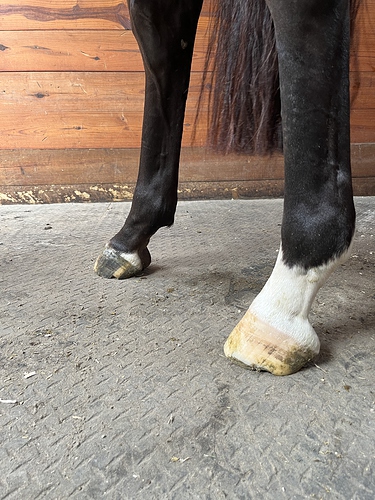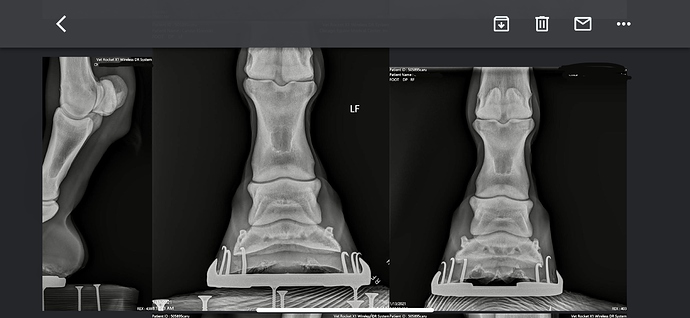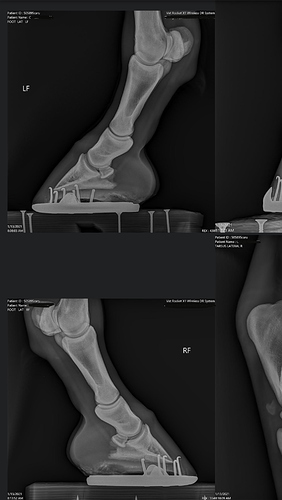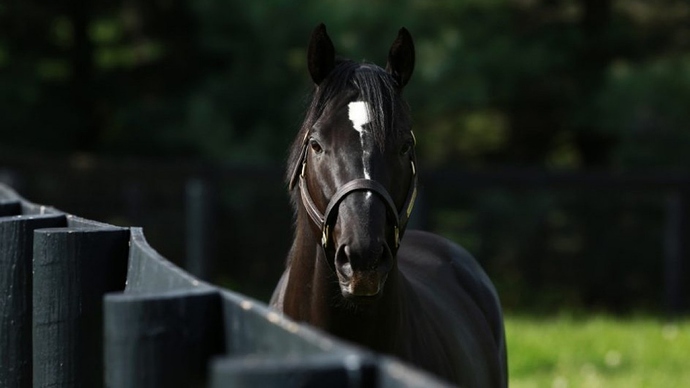Very cute and you look comfortable with him! I agree with the comments about farrier, especially the hind angles - he looks pretty negative to me, and that’s a common problem in TBs. It can significantly affect the back and SI. I’d also shoot rads to look for kissing spines, after dealing with this and my TB, can honestly say I will never travel this road again. Nothing short of incredibly distressing.
Fortunately we do have a different farrier (prospect is at a farm nearby) who’s pretty good. Our trainer was also unsure why his left and right were shod differently. Will definitely request images if they’re not already in his records from last year.
He also previously had back shoes but his owner removed them for economical reasons. I’d probably consider putting them back on, timing to be discussed w our farrier.
@beowulf can you point out where in the videos you saw the inconsistent steps? I’m trying to train my eyes to be better so it’s always helpful when people can show me things they’re seeing that I’ve missed!
Can you elaborate on how they were shod differently on the hinds? I would definitely look into that as that is a red flag for me.
He looks to have pretty typical TB feet. The hoof walls do not look the strongest, he will highly likely need to stay shod to remain sound, and he does have a high and low heel on the fronts which may be normal for him (it is normal for many horses). The front left’s heel is more under run and it appears the steel shoes are creating friction on the heels which is causing the front feet, especially the left, to perpetually have an under run heel and long toe. Not uncommon but I would be curious how frequently he is getting shod. His hoof wall and growth may not be ideal, preventing them from having a shorter shoeing cycle which is not ideal for correcting the heels. A good consistent farrier I think will be a must and I do not see him as a barefoot candidate.
He has had time off and understandably, will need to be brought back into work. I would do a thorough PPE to ensure he is not out of work because of unsoundness. He does throw himself into canter transitions which may be due to weakness but I would investigate that, especially with the unusual shoeing on the hinds, in the PPE.
ETA: I may have misunderstood which feet are being shod differently. Would love to know more about what differences in shoeing you saw.
Also, the hinds look slightly dubbed in the last post of the hind feet. Wondering if the hoof wall is chipping to the point of having to slightly over shorten the toe. He would likely be more comfortable shod on the hinds.
Sorry, I meant it’s his front feet that are shod differently. It’s a little hard to tell from the photo that I got but when looking straight on, the left front has a pretty normal shape whereas the right front has a slightly club foot shape.
Our trainer did point out issues with the front shoes, too. I don’t remember his exact words, though maybe he was picking up on the same things you pointed out.
Do you mean that the shoeing technique is different or that the shape of the front feet are different? If the technique is different, then that is a red flag. If shape is different, then not as big of a red flag.
The different shape is due to a high and low heel. The right front has a higher heel, the left front has a lower heel. Some horse’s have mismatched feet and lead sound careers despite that. You have to look at the balance of each foot individually when shoeing, therefore, the answer is not always to make each hoof look identical. The left front has a more pronounced underrun heel and longer toe than the right. I would be curious how often the horse is getting shod. If shod at 7 weeks, then the shoeing is likely not frequent enough to really correct the under run heel and long toe, especially when perpetuated by friction from the shoe lowering the heel and allowing the toe to grow long. This is a common problem with steel shoes. If being shod at 5-6 weeks, you should see better hoof balance with a skilled farrier. The horse may not grow hoof fast enough to have sufficient hoof wall to nail at 5 weeks, however. That is why I’d ask how often the horse is shod. Having a longer shoeing cycle is going to perpetuate those problems and not all horses have sufficient growth and hoof wall to reshoe at 5 weeks, though most do have something to work with with as long as they aren’t pulling shoes with a skilled farrier. If the horse has a tendency to pull shoes in combination with poor hoof walls, that can make nailing a shoe on every 5 weeks very difficult.
If you were an owner set on having a barefoot horse or had limited access to a good and consistent farrier, I’d say the hooves will likely be an issue. But if you don’t mind shoeing all 4s and have access to a good farrier, then the feet will likely not be an issue, just something that has to be managed. You can always try hoof supplements, etc., but a lot of horses just have a genetic disposition to a certain hoof type. This horse may be one of them.
The confirmation photo from 2020 shows him with nice short toes, so the long toes we see now aren’t from the track farrier.
He is very cute.
It’s the feet that are different shaped–so glad to know that’s not usually a big issue.
The BM confirmed he’s currently shod every 5 weeks and is due on Sept 5. So based on your notes, sounds like having a different farrier will benefit?
Looks like a handsome dude. I like x-rays, too, though they can complicate a decision. We’ve probably all known horses with imperfect images who nearly never set a foot wrong.
Is it rude to ask about his pedigree? I mean, because he’s a gelding, it’s totally idle curiosity. I love learning how the younger crops of TBs are linked to the older lines like Blushing Groom, Mr. Prospector, and a few other personal favorites.
The current farrier is doing the horse no favors but I can’t fully access why that may be without seeing the feet more. I’d make sure your PPE evaluates the feet and just have a vet access that the hoof wall, etc., is not is terrible shape.
There are some stress lines on the walls of the front feet that look to have occurred about 2 months or so ago. They aren’t terribly pronounced but sometimes that can indicate changes in the hoof. If they changed feed or training routine, started working him on hard surfaces, etc., the. that can create stress lines, but sometimes they are caused by laminitis episodes or inflammation in the feet. Something I’d also point out to your vet.
Yeah I get the same nervous feeling about images, too. I just got the vet records with the images they got from the PPE a year ago. I’m not seeing anything that looks like kissing spine. The rest of the images I’ll leave to the experts.
No problem sharing his pedigree. He does have Mr Prospector. I don’t recognize the sire’s line other than Storm Cat.
 Carson City.
Carson City.
The Blushing Groom - Mr. Prospector combination seems a good one.
Big bodied, easy going (for TBs), resilient horses.
Obviously there are more generations in between for the newer crops and plenty of lines I don’t know. I always look for those two, though, and Carson City is a lovely exemplar of the mix.
His father is Shanghai Bobby. He was a very good racehorse and cute! I don’t know what his disposition is like or how his offspring do as sport horses.
It looks like the high and low heel issue has been chronic. I would get your vet to check out the differences in palmar angle between the RF and LF and see if they have any concerns.
Here are a few pictures of his father (Shanghai Bobby). He was at a farm in Kentucky but now he’s in Japan.
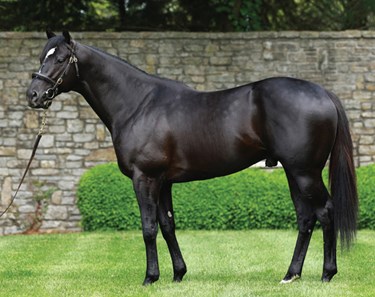
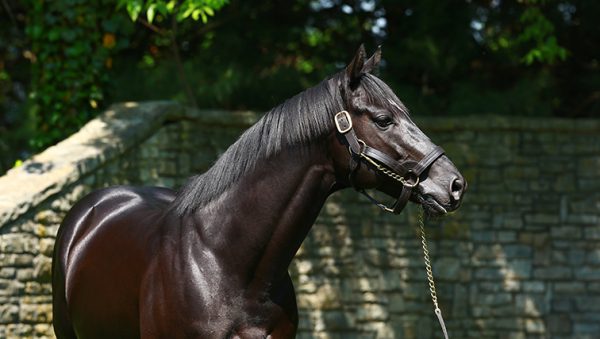
Thanks for sharing these! He definitely inherited his dad’s big withers.
Sure.
The first video, the first few seconds at a walk you can see there is a difference in the range of motion (ROM) of both hinds. He is slightly hock wringing; where their foot rotates in place as the limb loads and unloads. When he comes across the diagonal you can see he is tracking up most of the time, but a few times that non-sock hind comes down quicker.
At the trot you see the hind with a sock deviate to the inside very slightly.
The most glaring thing to me was the difference in separation of hinds at the canter, going from right to left.
Now, it’s perfectly normal for a horse to have one stronger and weaker side. It’s perfectly normal for a green horse to not have clean canter departs or transitions. From my four minute impression of the videos he looks stronger going to the left than right. He seems to prefer landing on the left lead over fences too and did not want to swap to the right lead on a few turns.
I still like him. He seems very quiet and honest, looks like he enjoys jumping too.
Thanks for the details!
That’s interesting what you picked up on the right hind b/c yesterday at the PPE she mentioned there was some fluid in that leg. She couldn’t say what might be causing it (mentioned possibly arthritis?) without further digging but didn’t seem overly concerned.
She also pointed out the left lead being better than the right. Getting him going off the right in the saddle was also a little harder.
I know it’s both petty and unwise to covet a horse purely based on looks, but this fellow brought out my childhood Black Stallion fantasies and made my heart go pitter-patter! 


One thing to consider with a horse with high/low shoulder is saddle fit.
Horses with high/low tend to have asymmetry in the wither shoulder area.
You’ll want a good saddle fitter who can re flock the saddle or get a saddle pad with pockets for shims.
This isn’t a deal breaker and I wouldn’t be put off by it, but is something to take into consideration if you are seriously interested in this horse.
Good luck.

